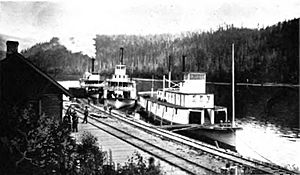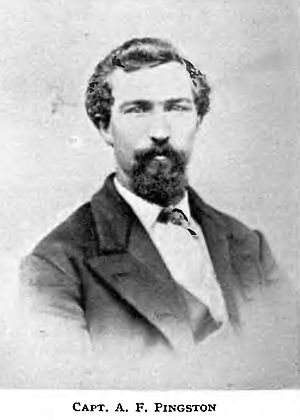Kootenai (sternwheeler) facts for kids
The Kootenai was a special type of boat called a sternwheeler. It sailed on the Arrow Lakes in British Columbia, Canada, between 1885 and 1895. It was only the second sternwheeler ever to travel on these lakes. Don't confuse it with another boat named Kootenay, which was built later in 1897 and also sailed on the Arrow Lakes.

sternwheelers Lytton (in distance), Columbia (center), and Kootenai(on right) at Robson, BC, sometime between 1890 and 1894
|
|
Quick facts for kids History |
|
|---|---|
| Name | Kootenai |
| Owner | Henderson & McCarthy; Columbia & Kootenay Steam Navigation Co. |
| Route | Arrow Lakes |
| Builder | Northport, Washington |
| Launched | April 25 or 27, 1885 |
| Maiden voyage | May 7, 1885 |
| In service | 1885 (laid up 1886-1890) |
| Out of service | 1895 |
| Identification | US 14436 |
| Fate | Sank near Wigwam, BC, raised and scrapped |
| General characteristics | |
| Type | inland shallow-draft boat passenger/freighter |
| Tonnage | 371 gross; 269 net |
| Length | 139 ft (42 m) |
| Beam | 22 ft (7 m) |
| Depth | 5.0 ft (2 m) depth of hold |
| Installed power | steam engines manufactured 1877 by Willamette Iron Works of Portland, Oregon, twin single-cylinder, horizontally mounted, 14" bore by 60" stroke, 13 horsepower nominal |
| Propulsion | sternwheel |
Contents
Building the Kootenai Steamboat
The Kootenai was built in a unique way. First, a company called Paquet & Smith made the main wooden parts, called frames, in Portland, Oregon. These frames were made from strong Douglas fir wood.
Assembling the Ship's Hull
After the frames were ready, they were sent by ship to a place called Little Dalles. Today, this place is known as Northport, Washington. It's located in the Washington Territory, close to the border with British Columbia. Once the frames arrived, two contractors, Henderson and McCartney, took over. They worked for the Canadian Pacific Railway. A shipbuilder named E.G. Thompson also helped. They put together the rest of the ship's body, called the hull. They used planks and timbers cut right there from local pine trees.
The Ship's Engines
The steamboat's engines were not brand new. They had been used twice before! They were built in 1877 by Willamette Iron Works in Portland, Oregon. These engines were first used in a boat called the McMinnville. That boat sailed on the lower Columbia River. Later, the engines were moved to another steamboat, the Katie Hallett, which sailed on Pend Oreille Lake.
Sailing the Arrow Lakes Route
Steamboats like the Kootenai could only sail on the rivers and lakes in this area for part of the year. This was usually from May 15 to October 30. During other times, the water would be frozen or too low for boats to travel safely. Companies tried to launch their steamboats early in the season to make the most of the good weather. The Kootenai was launched in late April 1885, and its first trip was in May. This timing was perfect for the sailing season.
On May 7, 1885, Captain A.L. Pingston took the Kootenai on its first journey. He had also been a captain for another steamboat, the Forty-Nine, years before. The Kootenai carried supplies and building materials. These were needed for the construction of the Canadian Pacific Railway. The route went north through the lower and upper Arrow Lakes. Then it continued further north up the Columbia River to a town called Farwell. This town is now known as Revelstoke. Farwell was an important spot because the transcontinental railway line crossed the Columbia River there.
The Kootenai's first trip up the river and lakes took 30 hours. Before this, only a few other steamboats had made this journey. These included the Forty-Nine in the 1870s, and two small steam launches, the Midge and possibly the Alpha, in 1884 and 1885. On that first trip, Captain Pingston had to carefully search for the right path in the water. He also had to guide the steamboat through rapids. Sometimes, he would attach a rope to a tree or a rock on the riverbank. Then, he would use a special winch, called a capstan, to pull the steamboat upstream. Later trips became faster as the crew and captain learned the route better.
Challenges and Changes
On September 4, 1885, the Kootenai hit some rocks at Little Dalles. Luckily, it was saved and repaired. The steamboat then stayed at Little Dalles for the winter. Sadly, Captain Pingston died in an accident on April 27, 1886. That year, the Kootenai only made one trip to Revelstoke, with Captain Nathaniel Lane in charge. After that, the Kootenai was not used until 1890.
In 1890, the Columbia and Kootenay Steam Navigation Company bought the Kootenai. They paid $10,000 for it. The new owners used the Kootenai for passengers and cargo at the start of the 1890 season. It made enough money in just a few trips to pay off what they owed! Later in 1890, a new sternwheeler called the Lytton started service. After that, the Kootenai was mainly used to carry freight. In the 1890 season, the Kootenai made 27 trips up and down the lakes. These trips started on May 13 and ended on August 12.
The End of the Kootenai
On December 3, 1895, the Kootenai hit a rock again. This happened near Bannock Point and Wigwam, BC on Upper Arrow Lake. Even though the steamboat was pulled off the rock, it was decided that it wasn't worth fixing. The Kootenai was then towed to Nakusp, BC. There, it was taken apart, or dismantled. The engines and other useful parts from the Kootenai were later used to build a new sternwheeler called the Trail.


